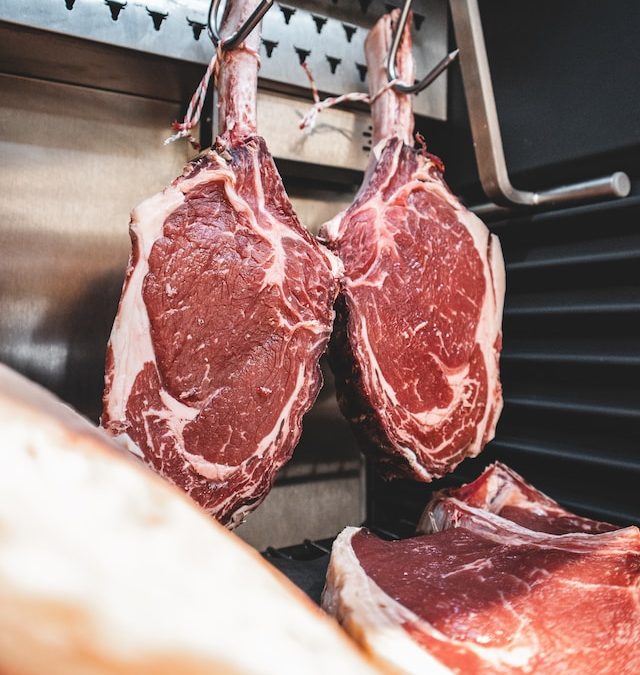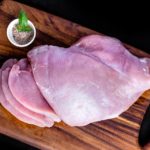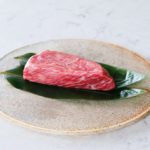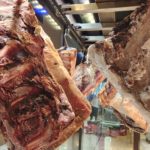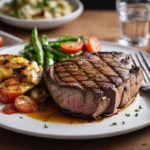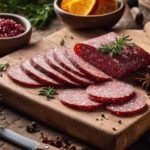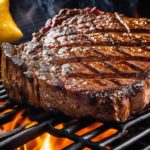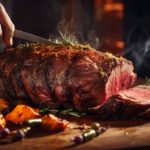Ever wondered why that dry-aged steak at your favorite restaurant tastes incredibly delicious? It’s all down to a science technique known as “dry aging“, which lets nature do its magic on the meat, elevating its flavors and tenderness.
In this article, we’ll break down the complex process behind dry aging and how it enhances the flavor of your beef like nothing else can. Ready for some juicy details?.
Key Takeaways
- Dry aging is a process that enhances the flavor and tenderness of meat by letting it dry in a controlled environment for weeks or even months.
- Enzymes play a crucial role in the dry aging process, breaking down muscle fibers and connective tissues to improve tenderness and develop unique umami and nutty flavors.
- Factors like time, temperature, humidity control, air flow, and oxygen exposure affect the success of dry aging. Optimal conditions include maintaining temperatures between 34°F (1°C) and 38°F (3°C), humidity levels at around 85%, proper air circulation, oxygen presence for beneficial bacteria growth, and regular monitoring of settings.
- Dry aging offers benefits such as improved tenderness, enhanced flavor and aroma, as well as concentration of natural juices within the meat.
What is Dry Aging of Meat?

Dry aging of meat is the process of aging and enhancing the flavor of meat by letting it dry in a controlled environment.
Definition and process of dry aging
Dry aging is a craft. It’s all about making meat taste great. This process works on beef to give it more flavor and tenderness. A butcher lets the beef sit in a controlled place, usually for weeks or even months.
The place has special controls for coldness and wetness. The air can flow around the meat too. As time goes by, the natural parts inside the beef do their magic job of breaking down hard stuff in the meat called collagen.
This makes it softer to eat and adds depth to its taste! While this happens, water also leaves from within the beef — think like squeezing out a sponge but slowly over time — so flavors become stronger as well.
How dry aging enhances meat flavors
Dry aging makes meat taste better. It is a science that changes beef into a tasty treat. The meat sits in a cool place for many days, even weeks! As it sits, something great happens.
Natural helpers called enzymes start to work on the beef. They break down hard parts inside the meat that can be tough to chew. This makes dry aged steak soft and easy to eat.
As time goes by, water leaves the meat too. Now, you might think this is bad but it’s really not! Less water means more flavor gets packed into each bite of the cooked steak because there is no extra juice left to dilute it.
Also as these enzymes do their job, they create new flavors in the beef. One flavor we find in dry-aged steak is ‘umami’. Umami gives food its yummy savouriness – like what you taste when eating mushrooms or tomato sauce!
These steps together make your piece of dry aged beef take on deep and complex flavors that are rich and mouth-filling which will delight any lover of steaks!
The Science Behind Dry Aging

During the dry aging process, enzymes break down muscle fibers and connective tissues in the meat, leading to improved tenderness and a concentration of flavor compounds that develop unique umami and nutty flavors.
Enzymatic breakdown of muscle fibers and connective tissues
Enzymes play a big part in making dry aged steak so tasty. Inside the meat, these enzymes get very busy when beef starts to age. They break down proteins and fat. This is how we get a piece of steak that’s soft to bite into.
The breakdown also changes how the beef tastes. It brings out deep, rich flavors in the meat as enzymes do their work on muscle fibers and connective tissues. These changes happen over time and make every bit of dry-aged steak a treat for your taste buds!
Concentration of flavor compounds
During the dry aging process, the flavor compounds in meat become more concentrated. This means that the flavors become stronger and more pronounced. The enzymes inside the meat break down proteins and fat, creating molecules that contribute to the rich and savory taste of dry-aged beef.
As moisture evaporates from the meat, it allows these flavor compounds to become more concentrated, resulting in a more intense and unique flavor profile compared to other aging methods.
So when you bite into a dry-aged steak, you can expect a burst of delicious flavors that will make your taste buds dance with joy!
Development of umami and nutty flavors
During the process of dry aging, enzymes within the meat break down proteins and connective tissues. This breakdown releases flavor compounds that contribute to the development of unique flavors in the meat.
Specifically, dry aging enhances umami flavors, which are known for their savory and rich taste. Additionally, nutty flavors also develop during this process, adding another layer of complexity to the overall flavor profile of the meat.
These delicious flavors are a result of controlled decomposition and concentration of compounds that occur during dry aging.
Factors Affecting Dry Aging
The factors that can affect the dry aging process include time, temperature and humidity control, as well as air flow and oxygen exposure.
Time: Minimum recommended aging period
Dry aging is not a quick process. It takes time for the flavors to develop and for the enzymes to break down the meat fibers. The minimum recommended aging period for dry aging beef is around 14 days, although some experts suggest longer periods like 21 or even 30 days.
This extended time allows for more flavor concentration and tenderness development. So if you want that delicious dry-aged steak experience, be prepared to wait patiently while the magic happens!
Temperature and humidity control
Controlling the temperature and humidity is crucial in the dry aging process to achieve the desired results. Here are some important points to consider:
- Maintain a temperature between 34°F (1°C) and 38°F (3°C). This range helps slow down bacterial growth while allowing enzymes to work their magic on the meat.
- Keep the humidity level at around 85% to prevent excessive moisture loss from the meat. This balance ensures proper drying without drying it out completely.
- Invest in a quality refrigerator or aging chamber that allows you to regulate both temperature and humidity levels accurately.
- Use a hygrometer to measure the humidity levels inside your aging chamber or fridge. This tool will help you adjust the conditions accordingly.
- Regularly monitor and adjust the settings based on how your meat is responding to the aging process.
Air flow and oxygen exposure
Air flow and oxygen exposure play a crucial role in the dry aging process. Proper air circulation is important to allow moisture to evaporate from the meat, which helps enhance its flavor.
The presence of oxygen also allows for the growth of beneficial bacteria that break down proteins and fats, resulting in a more tender and flavorful steak. However, it’s essential to maintain a controlled environment with the right temperature and humidity levels to prevent spoilage or excessive drying out of the meat.
So, by ensuring adequate air flow and oxygen exposure, you can help create the perfect conditions for dry aging your meat and achieving that delicious taste you crave.
Benefits of Dry Aging
Dry aging offers several benefits for meat lovers. It improves tenderness, enhances flavor and aroma, and concentrates natural juices within the meat. Discover how dry aging can elevate your steak experience!
Improved tenderness
Dry aging is not just about enhancing flavor; it also significantly improves the tenderness of meat. During the process, enzymes break down the tough connective tissues in the muscle fibers, resulting in a more tender texture.
As these proteins break down, they transform into molecules that enhance both flavor and tenderness. The longer meat is aged, the more tender it becomes. So when you enjoy a dry-aged steak, you can expect not only rich flavors but also melt-in-your-mouth tenderness that will truly elevate your dining experience!
Enhanced flavor and aroma
Dry aging is a process that enhances the flavor and aroma of meat. When beef is dry aged, enzymes break down the muscle fibers and connective tissues, making the meat more tender. Additionally, as moisture evaporates during the aging process, the flavors become concentrated, resulting in a richer taste.
This concentration of flavor compounds creates a unique and intense flavor profile that cannot be achieved with regular aging methods. So if you’re a meat lover looking for steaks with exceptional flavor and mouthwatering aroma, dry aged beef is definitely worth trying!
Concentration of natural juices
Dry aging enhances the concentration of natural juices in meat, resulting in a more flavorful and succulent eating experience. During the dry aging process, moisture evaporates from the meat, leaving behind a more concentrated flavor profile.
This concentration of natural juices intensifies the taste and richness of the meat, making it incredibly satisfying to bite into. The controlled decomposition of beef through dry aging allows for these juices to develop and infuse into every fiber of the meat, ensuring that each bite is packed with deliciousness.
So when you sink your teeth into a perfectly dry-aged steak, you can expect an explosion of mouthwatering flavors that will leave you craving for more.
Comparison to Alternative Aging Methods
Wet aging is a commonly used alternative to dry aging, but it produces different effects on the flavor and texture of meat.
Wet aging vs. dry aging: Differences and effects on flavor
When considering the best way to age meat, two popular methods stand out: wet aging and dry aging. Each technique has its unique characteristics, resulting in different effects on the flavor of the meat.
| Method | Process | Effect on Flavor |
|---|---|---|
| Wet Aging | This process involves vacuum-sealing the meat and allowing it to age in its own juices. It’s a quick and relatively inexpensive method, with the aging period typically spanning between 4 to 10 days. | Wet aging enhances the meat’s natural flavors, making it more tender. However, it may lack the depth of flavor that comes with dry aging. |
| Dry Aging | During dry aging, the meat is exposed to a carefully controlled environment with specific temperature, humidity, and airflow settings. The period for dry aging can run between 15 to 28 days, or even longer for a more intense flavor. | Dry aging results in a significant concentration of natural juices in the meat, intensifying the flavors. The process leads to the development of complex flavors like umami and nuttiness, which can be a real treat for meat lovers. |
Whether you prefer the rich, concentrated flavors of dry-aged meat or the tender, enhanced natural flavors of wet-aged meat, both methods offer a unique gastronomic experience. The choice ultimately depends on your personal preference.
Other aging methods (e.g. vacuum aging)
Other aging methods, such as vacuum aging, are also used to enhance the flavor and tenderness of meat. Here’s what you need to know:
- Vacuum aging involves placing the meat in a vacuum – sealed bag and allowing it to age. This method helps to retain moisture and results in a juicier end product.
- The vacuum – sealed environment prevents the growth of bacteria, reducing the risk of spoilage and ensuring food safety.
- Vacuum aging is typically a shorter process compared to dry aging, with a minimum recommended aging period of around 10 days.
- While vacuum aging can improve tenderness, it may not develop the same depth of flavor as dry aging. The absence of airflow limits the concentration of flavor compounds.
- Some experts argue that vacuum-aged beef may have a milder and less pronounced flavor compared to dry-aged beef.
- Vacuum-aged beef is often more readily available in supermarkets and grocery stores compared to dry-aged beef, which is more commonly found in specialty butcher shops.
Tips for Dry Aging at Home
To successfully dry age meat at home, you’ll need the right equipment, like a dedicated refrigerator or cooler and a dry aging bag. Keep the temperature and humidity well-controlled, be mindful of airflow and oxygen exposure, and always prioritize safety in your process.
Necessary equipment and storage conditions
To properly dry age meat at home, you will need the following equipment and create the ideal storage conditions:
- Refrigerator: Use a dedicated refrigerator that has a separate temperature control. This ensures that the temperature remains consistent throughout the aging process.
- Wire rack: Place the meat on a wire rack to allow for air circulation around the entire piece. This helps with proper drying and prevents any moisture buildup.
- Dry aging bags: Seal the meat in specialized dry aging bags or cheesecloth to protect it from external contaminants while still allowing for moisture evaporation.
- Temperature and humidity control: Set the refrigerator temperature between 34°F (1°C) to 37°F (3°C). Humidity should be maintained at around 80% to prevent excessive drying of the meat.
- Proper airflow: Ensure there is good airflow around the meat by keeping some space between each piece and avoiding overcrowding. This promotes even drying and reduces the risk of spoilage.
- Aging duration: Depending on your preference, age your meat for anywhere between 21 to 45 days to achieve desired flavor and tenderness.
Safety considerations and best practices
- Ensure that the meat is from a reliable source and has been properly handled and stored before dry aging.
- Use a designated fridge or aging cabinet with controlled temperature and humidity to prevent bacterial growth.
- Clean and sanitize all equipment, including the shelves, racks, and utensils used for dry aging.
- Trim off any excessive fat or external contaminants from the meat before beginning the aging process.
- Place the meat on a wire rack or in a dry aging bag to allow for proper air circulation while preventing cross-contamination.
- Regularly check the meat for any signs of spoilage, such as unusual smells, discoloration, or mold growth. If any of these are present, discard the meat immediately.
- Do not overcrowd the fridge or aging cabinet to ensure proper airflow around each piece of meat.
- Keep a log to track the length of time the meat has been aged, as well as any observations or notes about its condition throughout the process.
- When handling the aged meat, always use clean utensils and surfaces to avoid introducing bacteria onto the surface of the steak.
- Once ready to cook, make sure to thoroughly cook the steak to an appropriate internal temperature to eliminate any potential foodborne pathogens.
Remember that following these safety considerations and best practices will help ensure that your dry-aged meat is safe to consume and enhances your dining experience.
Conclusion
In conclusion, the science behind dry aging is fascinating. By breaking down collagen and concentrating flavors, this process creates meat that is more tender and flavorful. Enzymes in the meat work their magic, creating molecules that enhance both taste and tenderness.
Whether done by professionals or at home, dry aging is a technique beloved by meat lovers for its ability to elevate the quality and flavor of beef.
FAQs
Q: What is dry aging?
A: Dry aging is the process of aging fresh meat in a controlled environment without any packaging or preservatives.
Q: How does dry aging enhance the flavor of meat?
A: The process of dry aging allows natural enzymes in the beef to break down the proteins, resulting in more tender meat with a concentrated beef flavor.
Q: Why is dry aged steak considered superior to regular steak?
A: Dry aged steak is considered superior because the aging process allows the meat to develop a more intense flavor, improved tenderness, and a unique nutty and buttery taste.
Q: What cuts of beef are commonly used for dry aging?
A: Different cuts of beef can be dry aged, but some popular choices include ribeye, strip loin, and tenderloin.
Q: How long does it take to dry age beef?
A: The aging time for dry aged beef can vary, but it typically ranges from 21 to 45 days.
Q: Can I dry age beef at home?
A: Yes, it is possible to dry age beef at home, but it requires a specialized method and controlled environment to ensure food safety.
Q: What is the process of dry aging?
A: Dry aging involves hanging the beef in a temperature and humidity-controlled room. During this time, the beef ages naturally as moisture evaporates from the surface and the natural enzymes in the meat break down proteins.
Q: How does dry aging improve the tenderness of the meat?
A: During the dry aging process, the natural enzymes in the beef break down the connective tissues, resulting in a more tender and melt-in-your-mouth texture.
Q: Can dry aged meat be cooked like regular meat?
A: Dry aged meat can be cooked like regular meat. However, it is recommended to cook dry aged steak to a lower temperature than regular steak to preserve its tenderness.
Q: What is the best way to enjoy the unique flavor of dry aged beef?
A: To fully enjoy the unique flavor of dry aged beef, it is recommended to cook it with minimal seasoning and serve it medium-rare or medium to maximize the tenderness and flavors.
Greetings!
With over two decades of diverse experience in the meat industry, I proudly stand as an expert in all things meat. My journey commenced with a strong foundation in hospitality, where I honed my culinary skills as a chef in prestigious restaurants and on luxurious superyachts worldwide.
However, my true passion lies in the art of butchery. Throughout my extensive career, I have had the privilege of working with renowned meat purveyors and mastering the craft of meat cutting and preparation. From breaking down whole carcasses to meticulously selecting prime cuts, my butchery expertise is at the core of my meat knowledge.
Having immersed myself in various cultures and cuisines, I have honed my skills to deliver exceptional dining experiences, crafting delectable dishes that celebrate the natural flavors of different meats. Whether it's sourcing the finest meats for discerning clients or sharing valuable tips on meat selection and cooking, I take pride in elevating the meat experience for both professionals and enthusiasts.
My journey has taken me from the bustling kitchens of top-rated restaurants to the heart of meat processing facilities, gaining insights and honing my skills to become a true meat connoisseur. Now, I am enthusiastic about sharing my expertise, offering valuable insights on meat selection, cooking techniques, and the art of butchery.

